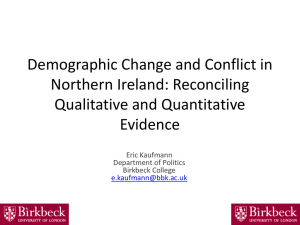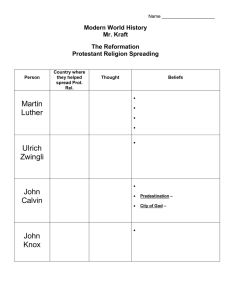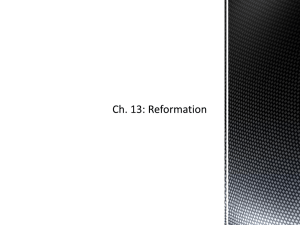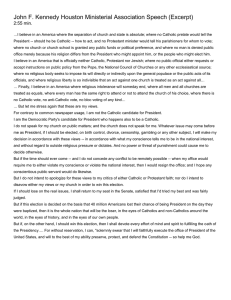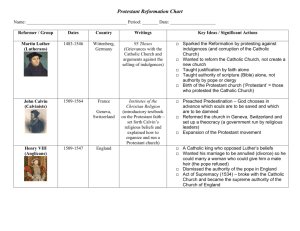Truce or Transformation?
advertisement
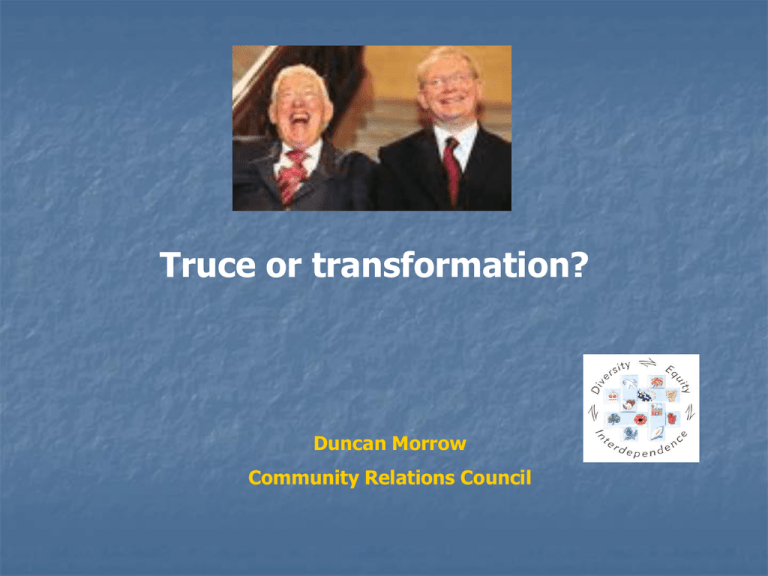
Truce or transformation? Duncan Morrow Community Relations Council Northern Ireland Unionist/Protestant Nationalist/Catholic 65%---55% 35%-45% Loyalist Resistance A state of antagonism • • • • • Different experiences of the state. law and justice Fear is rational, defining the limits of trust, the requirement to resist and the discourse of politics Separation (institutional, social and physical) – structured by fear, generating solidarity and structuring memory and meaning Culture as antagonism – religion, sport, symbols Collapse of critical categories: Crime, violence, democracy, rule of law (including HR), citizenship, equality • The ‘community’ as the locus social cohesion, not the state nor the person • Failure of class and economics to penetrate politics Unionist Nationalist ‘Homeland Security’ and the need for defence justify the removal of rights and segregation, especially in housing and education. Paramilitary formations emerge understanding themselves as defensive forces. Because ‘they’ are the cause, political progress requires ‘them’ to change Peace with the ‘evil’ enemy is easily equated with INjustice. Nationalist Unionist Unionist Sinn Fein USA EU Core Values: Consent, Equality and Human Rights Bridging Social Capital Purely political means Rule of Law Power-sharing Loyal Disloyal 1.7m Unionist Nationalist They used to be the problem Now ‘ They are our permanent partner The politics of paradox Truce or transformation? Unionist Nationalist Violence is contained Suspicion and fear underpin social choices Antagonism structures community Partnership is built-in to politics Sharing is ‘the new black’ Sharing is nobody’s aspiration Peace and Justice must be pursued together Justice requires punishing the guilty 100 90 80 70 60 50 40 30 20 10 0 19 89 19 91 19 93 19 94 19 95 19 96 19 98 19 99 20 00 20 01 20 02 20 03 20 04 20 05 20 06 20 07 per cent % believing that relations between Protestants and Catholics are better now than 5 years ago (NILTS) Year Protestant Catholic No religion 100 90 80 70 60 50 40 30 20 10 0 19 89 19 91 19 93 19 94 19 95 19 96 19 98 19 99 20 00 20 01 20 02 20 03 20 04 20 05 20 06 20 07 per cent % believing that relations between Protestants and Catholics will be better in 5 years time(NILTS) Year Protestant Catholic No religion Overlap between nationality and religion (NILTS 2007) Catholic Protestant Other All British 4 33 2 39 Irish 26 2 <1 29 10 14 1 25 2 4 1 7 NI Other % saying they would prefer to live in a mixedreligion neighbourhood (NILTS) 80 70 60 50 40 Year Protestant Catholic No religion 20 07 20 06 20 05 20 04 20 03 20 02 20 01 20 00 19 99 19 98 19 96 19 95 19 93 19 91 30 20 10 0 19 89 per cent 100 90 100 90 80 70 60 Year Protestant Catholic No religion 20 07 20 06 20 05 20 04 20 03 20 02 20 01 20 00 19 99 19 98 19 96 19 95 19 93 19 91 50 40 30 20 10 0 19 89 per cent % saying they would prefer to send their children to a mixed-religion school (NILTS) The costs of antagonism Antagonism is about everything= policy paralysis Endemic paramilitarism – security above all Deterrence of investment and migration Duplication of services Distorted labour markets Disruption of tourism Poverty and violence Quality of life Challenges to change •Politics •The limits of political commitment •A culture of political opposition •The risks of serious leadership in public policy •The weakness of the state – control of territory •Economics •Vested interest in segregation •Paramilitarism and segregation as economics •Scale and scope •Culture •Antagonism as our culture Determinants of change International political pressure/assistance Economics of partnership There is no alternative Leadership and risk Deliberate Shared Space – Utility, Location, Design and Management Education and Youthwork Sources of Change • Post-holocaust Europe – violence and integration • Travel and technology – globalisation • Migration and economics From poverty and emigration to wealth and immigration and back again Migration More Muslims than Methodists • Social Cohesion and integration across Europe Interventions for change • Shared Institutions – Politics, Local Government, Police, Integrated Schools Umbrella Groups (NICVA, RCN). • Projects of Common Interest – Childcare, Social Enterprise, City Centre Management • Chequebook Partnership – PEACE, Government • Promoting Bridging Capital - IFI, EU, CRC Targeting Division in practice • Engaging core institutions – Trade Unions, Churches, Sport, Arts • Hard to reach groups • Third party mediation capacity • Difficult conversations – democracy, justice and freedom • Conflict Management - crisis intervention and high risk engagement • Victims work • Residential capacity • Leadership Development • Resources Development Opportunities for influence •Models of Practice •Partnership •Rule of Law •Policy Advocacy •Research and Publications •Resource Development •Events The past obstructs the future Ongoing segregation The weakness of shared aspiration Paramilitary structures The challenge to consociation – the road to equality is not an equal one • How do political parties deliver to ’the others’ without damaging their own voter base? • Equality will require diverse solutions - Change has emphasised the difference between loyalist and nationalist communities not generated similarity. • Good Relations does not mean instant harmony – rather it means developing a culture which can debate and decide these issues honestly, on the basis of evidence not political allegiance. January 2003: Launch of Consultation September 2003: Over 10,000 people respond January 2004: Clear preference for increased government commitment March 2005: Launch of Strategy document September 2007: Dead on arrival? Programme for Government • commitment to ‘a shared and better future’ – 14 times within the document • contained within the First and Deputy First Minister’s foreword • part of Minister’s launch of budget 2008-11 Truce to transformation • The acceptable level of division • War guilt and reconciliation • Imagining the scale of change • Plausibility and desirability • • International audience versus political base The impossibility of failure

